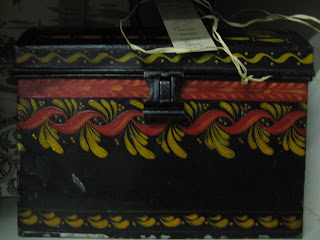
Iceland is a relatively new land mass, created by volcanic activity at the Mid-Atlantic Ridge
where the North American and European tectonic plates are separating (here is an actual crack of separation). 

The effects of this volcanic activity is one of the reasons Iceland is so oddly beautiful and incredibly picturesque.

Basalt fissures on the beach in a curved pattern.


The entire island is made of recent lava so nearly all rock is black (some are red from mineral deposits).
This means (almost) all the beaches have black sand, the country side is vast stretches of broken up black lava chunks, and even the urban sidewalks are black (well, grey) because they were made from ground up black lava. Many coastal areas are cliffs of hexagonal basalt columns formed by fissures when lava was rapidly cooled as it hit ocean water.
Here are some pictures near Snaefellsjökull peninsula (W. Iceland)
Me standing on a bridge created by water eroding some of the basalt columns.

Basalt fissures on the beach in a curved pattern.

As lava floes cooled over rivers and air vents, horizontal caves were formed
Primary organisms like lichens and moss must first grow, decompose, collect in the cracks and crevices, break up the rock and eventually make soil for larger plants to grow in. There is a lot of green in Iceland, and it's mainly from moss and lichen.
The time is takes for soil to build and trees to grow is part of the reason (combined with grazing sheep, wind and weather patterns) there are few forested areas.
One old forested area called Thórsmörk (Þórsmörk) in S. Iceland is situated in a warm, protected canyon and has small conifer and birch trees, ferns, and hundreds of mushrooms (at least on the day I was there). It has somehow avoided being covered in lava at different times and was thought to be a sacred place (deserving to be named after Þór/Thór).
(house/garage on Vestmannaeyjar/The Westman Islands off SW coast of Iceland destroyed by lava)
There is still considerable volcanic activity causing numerous (small) earthquakes on a daily basis not to mention the smoke plumes and threats of eruption by various volcanoes - remember Eyjafjallajökull (sounds like "A-yah-fyat-la-yuh-kult") last year whose smoke plumes closed European travel for a few weeks?
The geologic activity of the North American and European plates manifests itself in many ways beside volcanoes; thermal pools and geysers dot the island. The first geyser recorded is the one pictured below: Geysir or The Great Geysir, named after Geysir, a prominent Goði in early Iceland.
In Iceland, hot water from thermal water vents is collected and pumped into towns for domestic use. From the smallest villages to the largest city, Reykjavik, all hot water coming from the tap is untreated, straight out of the ground and smells like sulfur (something you get used and come to love to when taking a shower). All cold water coming from the tap is also straight out of the ground, but from a non-heated, non-sulfury source. If you want to make tea, for example, you let the cold water run for minute then fill the kettle to boil the cold water - if you use warm or hot water it will taste bad.
(Hot water pumping plant. The pipeline on the right goes directly to Reykjavik)
All the houses and building in Iceland are heated with hot water radiators powered by the naturally boiling-hot water pumped from the ground. I loved this (no hot, dry air blowing through your house) and it also makes heating a house nearly year-round quite inexpensive since all you pay is the cost of transporting the water.
Another use for the abundant hot water is as public pools; every town has a public bath, and large towns have several. Here, the natural, untreated hot springs water is cycled through tile or cement pools so the water never cools too much or becomes dirty because there is a constant flow of fresh water in and used water out. What is so awesome about this is you never have to think of wasting water - not to mention wasting hot water - because there is an endless source down the street
(The Blue Lagoon, not a typical bath house, but a fancy touristy one near the airport)
Laugardagur is the Icelandic word for Saturday, but it comes from "laugar" meaning to wash. Laugavegur is a street in downtown Reykjavik that used to be the women's trail to laugardalur (washing dale/valley) where they took their laundry to wash in the local hot springs.
This is my favorite picture of the Icelandic landscape because it captures all the aspects that were unique to me (coming from S California) and the "essence" of Iceland in my mind: dark sky from northern latitude, flat lava floes, small hills/mountains, green moss and lichen, and light dusting of snow.
























































